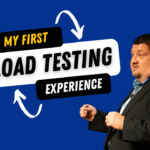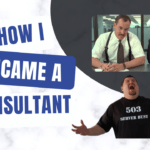In 2003, I was in a complete rut with my career. While my employer was always good to me, paid fairly, and had great benefits, I had hit the ceiling of what I could accomplish there. I knew something had to change, but I was confused about what to do about it.
The Performance COE – Remember Those?
I had built a performance Center of Excellence – a REAL one at Deloitte. Our team could handle performance testing for any of the internal applications for each line of business, and we provided a true internal services group that could do performance testing faster than any third-party consultant could. We had trained most of the project managers on what to do before requesting a performance test, so the planning portion of each project was pretty well underway before we even got involved. Technically, it was a well-oiled machine. Personally though, I was feeling like every day was the same. All we were doing was building new sandcastles (applications) and kicking them down for new ones each year.
Our performance testing service began to get a reputation. Outside groups wanted our help. Requests started coming in from places that were client facing, that would actually replace consultant work in the field (we only handled internal applications). It was at this time I began to think about working for myself. At first I was very risk averse to doing that, because I never considered myself entrepreneurial. I do not have a Masters degree in business. I had never run a business, but I knew a lot of idiots who had their own business. I figured if they could do it, so could I.
In early 2004, the company began an offshoring, outsourcing plan similar to many others during that time. It was a great opportunity for me to take the leap. While management was assuring everyone that outsourcing posed no threat to anyone’s job, in my case that probably wasn’t going to be true long term. It was time for me to make a move, before I got moved. I had already made the decision when the managing director came to my desk on a Friday and had “the talk” with me. How great it would be if I trained four other people how to do everything I knew how to do, so I could start doing other more wonderful things. I turned in my notice the following Monday. While I have no qualms with offshoring or outsourcing (and have many friends in that role), we weren’t having an honest conversation. I watched over the course of 24 months as almost every person I worked with at the time never got to do wonderful things, unless you consider wonderful things finding a new job somewhere else.
Making The Move
I left Deloitte in April of 2004. The day I announced I was leaving, I had 3 months of work queued up and ready to go. My personal network had gotten word that I was on the market. At that point, I thought, “Maybe this is a good thing.” My first gig was as a subcontractor for Orasi, performance testing a PeopleSoft web application. My wife and I stayed near Cocoa beach over the weekends at the client location. It was actually a great experience. Before I had finished that engagement, I another lined up. I began to get so many calls that I knew could not handle all of the work. I contacted several friends that I knew and trusted. I said, “Let’s do this together. We don’t need a boss. We can just do stuff, and no one can tell us we can’t.” A few of them took a chance with me. And that is how Loadtester Incorporated was launched.
My first major client was Fifth Third bank, and it was such a great learning experience. I worked there in the daytime, and in the evenings I taught the first two employees (Scott Combs and Mike Hendershot) my performance testing process. I figured this was MY outsourcing initiative. They would spend their days in the temporary apartment across from me practicing their exercises all day Monday through Friday and then fly home for the weekends. Many nights I taught in my pajamas and we all ate supper together. My wife is an Iron Chef, so we all were fed well. Fifth Third is in Cincinnati, and we are all from Florida originally. I remember picking up Scott and Mike from the airport with the outside temperature at 4 degrees. They are there standing outside, white air coming out of their nose and mouth. Just freezing and smiling. I figured if they were willing to do that for me, I would do everything I could to make sure they were taken care of as much as possible within my company. After about 6 weeks of solid immersion into performance testing methodology and a LoadRunner deep dive crash course, they were billable at the client. We were off and running with long term contracts, and I spent two winters in Cincinnati. I’m still very appreciative to Fifth Third bank for letting us work for them and help them with their performance efforts during that time.
We Did It
Every time we learned something new from an engagement, I would post it on the blog section of the Loadtester web site – mainly so we wouldn’t forget how to do it next time. I can’t tell you how many times those blogs have gotten me out of a jam. The me from the past helped me from the future several times. Apparently, a lot of others gained from those blog articles, too. Through sharing this information, other practitioners began to know who Loadtester was. That meant more phone calls, more engagements, and the need to hire more people. From 2004 until 2010, Loadtester had zero people in sales. We didn’t need one. People came to us and we kept everyone off the bench at least 90% of the time. We all had the same mindset, and were all headed in the same direction. It was an amazing time. I handled all the “business stuff” and my wife handled the books, and we rolled along almost like a family. And we did it without much knowledge of how to run a business at all. When I think back at the level of clients we worked with and how much we accomplished, I am amazed. We made plenty of mistakes, but we learned from them, and tried our best never to repeat them.
The Takeaway
Even if you aren’t the biggest risk taker, at some point in your life you may have to make the choice to take a leap of faith. When it comes to business, there are levels of risk and comfort. There is “educated risk” and less common, “sure things”. Only you know where your risk tolerance is. In the end, no one gets out alive. You have to decide if you want to try something and fail or not try something and live with regrets. Most of the time, the worst that can happen is you learn a valuable lesson. Had I stayed where I was, I would have probably been let go anyway. I could have stayed safe and just found another job in town, but I would have remained extremely unhappy and dissatisfied – knowing I could have done a lot more with my professional career. That nudge was all I needed. It turned out to be a pretty good decision. I get to do what I love to do on my terms.
What decision in your career made the biggest impact on who you are today?




